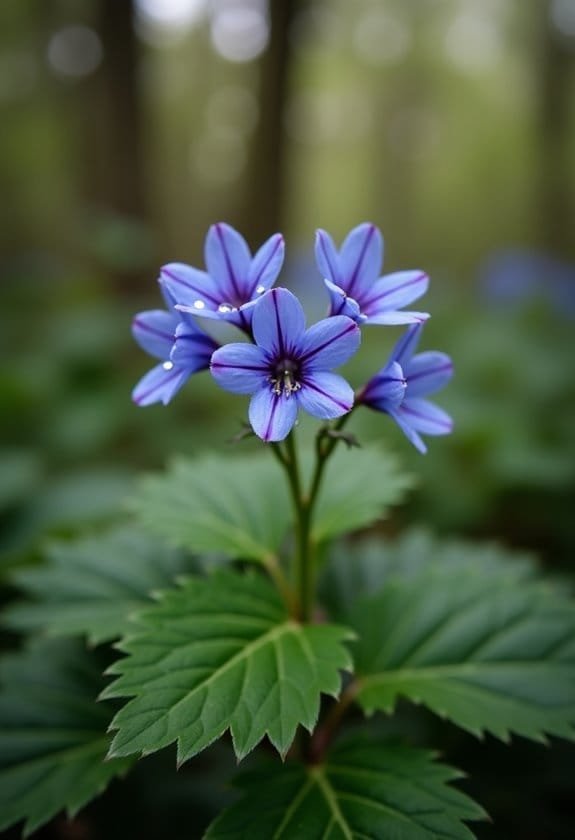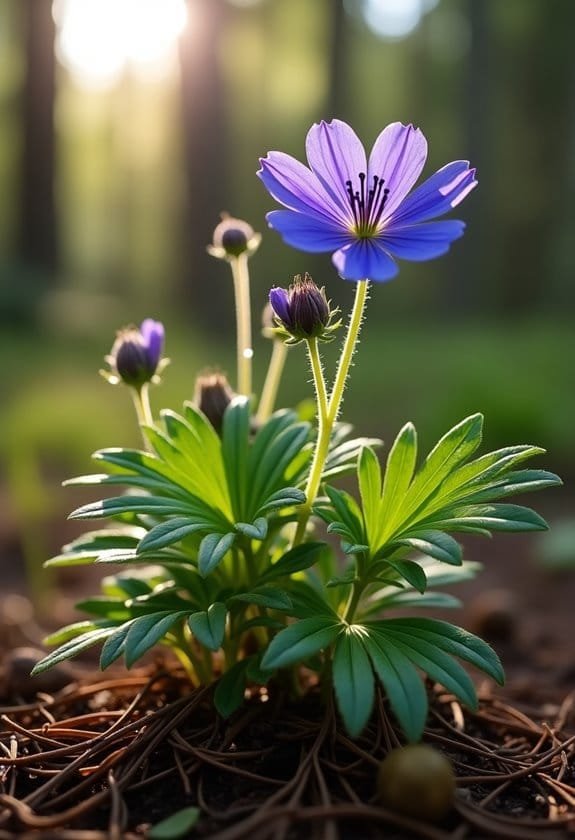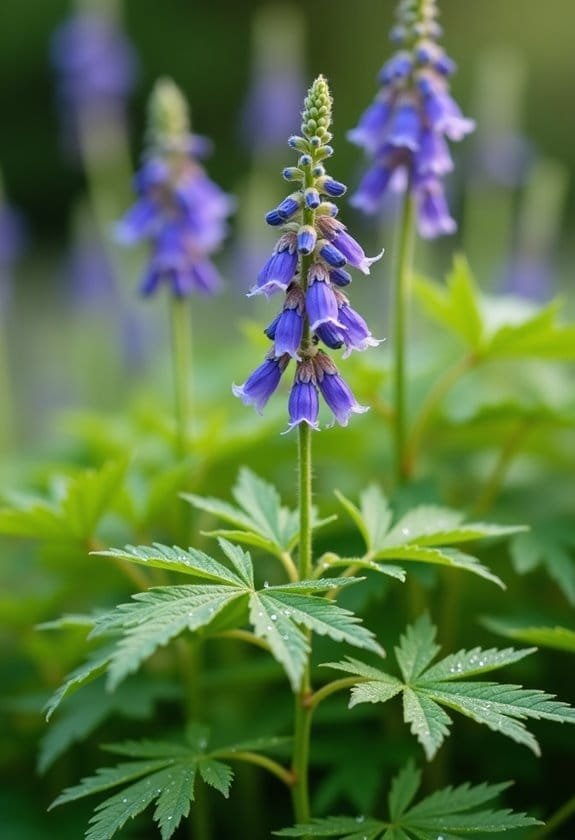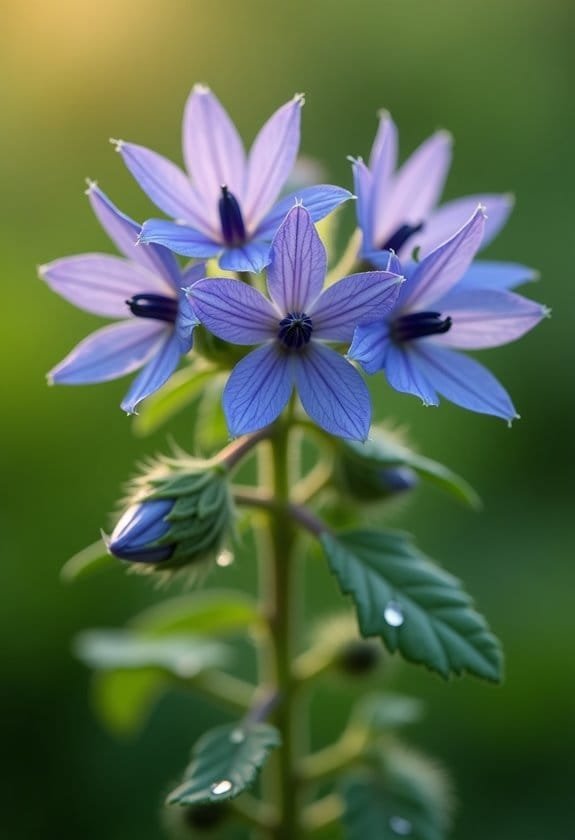Geranium pratense, commonly known as Meadow Cranesbill, is a resilient perennial that reaches heights of 2-3 feet and produces stunning violet-blue flowers from late spring through mid-summer. It's characterized by deeply-lobed foliage that shifts to bronze in autumn and distinctive crane-like seed heads that inspired its name. This adaptable plant thrives in USDA zones 3-9, preferring well-draining soil and tolerating conditions from full sun to partial shade. The flowers produce significant amounts of nectar (1.3-1.5mg daily), making it an essential resource for pollinators, while its sophisticated blooms and architectural form offer both ecological benefits and garden appeal. These remarkable characteristics only scratch the surface of this versatile plant's potential.
Main Points
- Meadow Cranesbill is a perennial wildflower reaching 2-3 feet tall with blue-violet flowers blooming from late spring through mid-summer.
- Native to meadows across Europe and Asia, this plant thrives in USDA zones 3-9 with full sun to partial shade exposure.
- The deeply-lobed leaves turn bronze in autumn, while the distinctive crane-like seed pods give the plant its common name.
- Attracts pollinators with nectar-rich flowers containing 57-71% sugar concentration and produces 1.3-1.5mg of nectar daily.
- Requires well-draining soil, consistent moisture while establishing, and good air circulation to prevent powdery mildew.
Introduction

Meadow Cranesbill (Geranium pratense), a distinguished member of the Geraniaceae family, stands as one of Europe's most elegant perennial wildflowers.
Its abundant, saucer-shaped blooms in vibrant blue to violet hues transform meadows and fields from late spring through mid-summer, creating sweeping carpets of color.
This hardy plant, reaching heights of 2-3 feet, combines ornamental appeal with ecological significance, serving as an essential resource for pollinators while showcasing its deeply-lobed foliage that shifts to bronze tones as autumn approaches.
Common Name
Known throughout Europe and Asia, the Meadow Cranesbill carries several common names that reflect its widespread presence in natural landscapes. While botanically classified as Geranium pratense, this versatile plant is frequently referred to as Common Cranesbill, particularly in British and European gardening circles.
The diverse nomenclature extends to include more descriptive names such as Crowfoot, which alludes to the shape of its deeply divided leaves, and Meadow Geranium, emphasizing its natural habitat preference.
These variations in common names have evolved through centuries of cultural and regional influences, with Wild Geranium being perhaps its most straightforward designation in everyday conversation.
The plant's scientific name, Geranium pratense, directly correlates with one of its most popular common names, as "pratense" refers to its meadow habitat.
Each regional name offers insight into either the plant's appearance, its preferred growing conditions, or its historical uses, making the Meadow Cranesbill a fascinating example of how botanical nomenclature can reflect both cultural heritage and botanical characteristics.
Scientific Name
The formal scientific name Geranium pratense perfectly captures both the physical characteristics and habitat preferences of this elegant perennial. As a member of the distinguished Geraniaceae family, its genus name "Geranium" draws inspiration from the Greek word "geranos," meaning crane, which aptly describes the distinctive beak-like fruit structure of the plant.
The species epithet "pratense," which translates to "of the meadow," reflects this plant's natural affinity for open grasslands and meadow environments. Native to Europe and Asia, Geranium pratense has demonstrated remarkable adaptability across diverse climate zones, thriving in USDA hardiness zones 3 through 9.
The scientific classification not only serves taxonomic purposes but also provides valuable insights into the plant's evolutionary history and ecological preferences.
This well-documented species has garnered significant recognition in horticultural circles, earning multiple Award of Garden Merit distinctions for its reliable performance and ornamental value.
The scientific name's precise descriptive nature continues to guide botanists, gardeners, and researchers in understanding this versatile perennial's characteristics and cultivation requirements.
Overview
Throughout gardens and meadows across Europe and Asia, Geranium pratense stands as a stunning example of nature's architectural beauty. This resilient perennial, commonly known as Meadow Cranesbill, commands attention with its impressive height of 2-3 feet and striking blue to violet blooms that grace gardens from late spring through midsummer.
The plant's remarkable adaptability allows it to flourish in diverse growing conditions, from full sun to part shade, while its deeply-lobed, palmate foliage creates an engaging display that transforms into rich bronze hues as autumn approaches. In well-drained, loamy soils across USDA hardiness zones 3-9, Meadow Cranesbill establishes itself as both an ornamental showpiece and an ecological cornerstone.
Beyond its aesthetic appeal, this versatile perennial serves multiple functions in the garden ecosystem. Its natural tendency to self-seed and spread creates sustainable ground coverage that helps prevent soil erosion, while its abundant flowers provide essential resources for pollinators.
The species' historical use in herbal medicine further underscores its significance, combining practical utility with ornamental charm in contemporary landscapes.
Key Features
Meadow Cranesbill stands as a robust perennial, reaching impressive heights of 2-3 feet with a naturally clumping growth habit that creates dense, architectural masses in the garden.
Its most striking features include the large, saucer-shaped flowers in vibrant blue to violet hues, which grace the plant from late spring through mid-summer, creating a spectacular display against its deeply-lobed foliage.
The plant's palmate leaves provide year-round interest, maintaining their rich green color throughout the growing season before shifting to enchanting bronze tones in autumn.
Growth Size
Reaching impressive heights of 2 to 3 feet (60-90 cm), Geranium pratense stands as a commanding presence in gardens with its deeply-lobed foliage and saucer-shaped blooms. This robust perennial, commonly known as Meadow Cranesbill, develops a substantial vertical profile that makes it an excellent choice for middle or back borders in landscaping designs.
The plant's growth size is particularly remarkable when considering its complete structure, from its fibrous root system to its spreading canopy. In full sun conditions, the foliage creates a dense mound that can spread laterally to match its height, establishing a balanced and proportional form.
The deeply-lobed leaves, which shift from green to bluish-green and eventually bronze, contribute greatly to the plant's impressive stature.
During the blooming period from late spring to mid-summer, the plant reaches its full dimensional potential, with flowering stems extending upward to support the vibrant blue to violet blossoms.
This vertical growth pattern, combined with the plant's natural tendency to self-seed, allows it to establish commanding clusters that create dramatic visual impact in garden settings.
Appearance
In accordance with its name, Geranium pratense showcases distinctive saucer-shaped flowers in vibrant shades of purple to blue, each featuring five perfectly formed oval petals and striking dark purple anthers. These elegant blooms emerge from late spring onwards, creating a mesmerizing display that draws both human admirers and beneficial pollinators to the garden.
The Meadow Cranesbill's foliage provides an equally compelling visual element, with deeply divided leaves featuring 7-9 pronounced lobes that create an intricate, lace-like appearance. As autumn approaches, these leaves transform into rich bronze hues, extending the plant's ornamental value well beyond its flowering season.
The plant's architectural structure is enhanced by its prominent seed capsules, which develop into elongated, beak-like formations characteristic of the cranesbill family. Dark purple veining patterns traverse each petal, serving both as natural landing strips for pollinators and adding subtle sophistication to the flower's appearance.
These delicate markings, combined with the plant's upright bearing and clustered blooms, create a sophisticated presence that bridges the gap between wild meadow charm and cultivated garden refinement.
Flowering Season
The flowering season of Geranium pratense begins as late spring warmth settles in, treating gardeners to a spectacular display that extends through mid-summer. The Royal Horticultural Society recognizes this period as ideal for the plant's nectar production, which reaches impressive levels of 1.3 to 1.5 mg per day with remarkably high sugar concentrations between 57% and 71%.
During its peak blooming phase, Geranium pratense (Meadow Cranesbill) produces an abundance of saucer-shaped flowers that transform gardens across the United States into vibrant displays of purple and blue hues. The plant's striking dark purple anthers serve as beacons for pollinators, ensuring robust reproduction throughout the growing season.
To maintain the flowering period's longevity, gardeners can employ strategic deadheading techniques, removing spent blooms to encourage fresh growth and subsequent flowering cycles. As the season progresses, the plant channels its energy into developing elongated seed capsules, which form after the primary flowering phase concludes, ensuring the next generation's survival while completing its annual reproductive cycle.
Growing Requirements

Meadow Cranesbill showcases remarkable adaptability in its growing requirements, flourishing in conditions from full sun to deep shade while maintaining its vigorous growth pattern.
The plant's success depends heavily on well-draining soil conditions, preferably in loamy or modified clay soils that prevent root saturation during wet periods.
Though it requires consistent moisture during its establishment phase, Meadow Cranesbill develops impressive drought tolerance once its root system matures, making it a practical choice for diverse garden environments across USDA zones 3-9.
Light
Sunlight plays an essential role in growing Meadow Cranesbill successfully, as this hardy perennial adapts well to both full sun and partial shade conditions. The plant's versatile nature allows gardeners to cultivate it in various light conditions, making it an excellent choice for diverse garden settings.
While Meadow Cranesbill demonstrates remarkable shade tolerance, peak growth and flowering occur when the plant receives substantial sunlight exposure throughout the day. In areas with partial shade, it continues to thrive, though blooming may be slightly less prolific than in full-sun locations. This adaptability stems from the plant's evolution in meadow environments, where light conditions naturally vary.
The relationship between light exposure and the plant's nectar production is particularly significant, as it generates 1.3 to 1.5 mg of nectar daily during flowering periods. This biological process, driven by photosynthesis, depends on adequate light reception to maintain consistent nectar yields.
Gardeners can maximize the plant's potential by positioning it where it receives morning sun and, if necessary, afternoon shade, especially in regions with intense summer heat.
Soil
Selecting the right soil conditions sets the foundation for healthy Meadow Cranesbill growth, with well-drained loamy soil being perfect for this versatile perennial. This adaptable plant demonstrates remarkable flexibility across various soil types, though it particularly flourishes in environments that strike a balance between moisture retention and proper drainage.
While Meadow Cranesbill can tolerate clay-based soils, implementing proper drainage solutions becomes essential to prevent water-logged conditions that might compromise root health. Gardeners can enhance their soil structure through targeted soil amendments, such as incorporating organic compost before planting, which enriches the growing medium with essential nutrients and improves its overall texture.
The plant's pH preferences aren't particularly demanding, though it shows peak development in neutral to slightly acidic conditions. During establishment, maintaining consistent soil moisture proves beneficial, especially during dry spells when supplemental watering becomes necessary.
For areas with heavy clay composition, creating raised beds or adding grit can greatly improve drainage, ensuring the soil provides an ideal balance of moisture retention and aeration for robust root development.
Water
Beyond soil composition, proper watering practices play a fundamental role in maintaining healthy Meadow Cranesbill plants. These perennials require a thoughtful watering schedule that balances their need for consistent moisture with their aversion to waterlogged conditions.
Regular moisture monitoring helps gardeners maintain this delicate equilibrium, ensuring the soil remains damp but never saturated. While young plants need consistent watering to establish strong root systems, mature Meadow Cranesbill specimens demonstrate remarkable drought resilience.
This adaptation means they'll require less frequent irrigation once they've developed their extensive root network. Gardeners should adjust their watering approach based on seasonal variations and local climate conditions, providing supplemental moisture during particularly dry spells.
The plant's relationship with water mirrors its natural habitat preferences, where it thrives in meadows with well-draining soils that retain adequate moisture without becoming waterlogged.
To prevent root rot and other moisture-related issues, it's crucial to check soil moisture levels regularly by inserting a finger into the substrate to a depth of approximately two inches, watering only when the soil feels dry at this depth.
Temperature
Temperature requirements for Meadow Cranesbill stand out for their remarkable flexibility across USDA hardiness zones 3-9. This impressive temperature adaptation strategy allows the plant to thrive in regions experiencing both frigid winters and warm summers, demonstrating its evolutionary success in diverse climates.
The plant's temperature resilience mechanisms become particularly evident in its germination process, where it exhibits a sophisticated two-phase approach. Initially, seeds require a moderate warm period of 15-20°C for 2-4 weeks, followed by an essential cold stratification phase at 0-4°C for 4-6 weeks. These specific temperature requirements guarantee ideal growth timing and seedling success.
Once established, temperature impact on growth reveals the plant's remarkable versatility. While Meadow Cranesbill prefers moderate temperatures and thrives in full sun to partial shade conditions, it's equipped to handle temperature fluctuations with remarkable grace.
Like a well-designed thermal regulator, the plant maintains its vigor across varying temperature ranges, making it an excellent choice for gardens in different climate zones while demonstrating notable drought tolerance in mature specimens.
Pollinator Criteria
Meadow Cranesbill's impressive nectar production of 1.3-1.5 mg per day, combined with its high sugar concentration of 57-71%, makes it a prime target for diverse pollinator species.
The plant's bluish violet flowers feature distinctive veining patterns that serve as natural landing strips, guiding bees and butterflies directly to their sweet reward.
As a melliferous herb blooming from late spring through mid-summer, Geranium pratense plays a crucial role in supporting local pollinator populations during their peak activity period, contributing considerably to ecosystem stability and honey production.
Attracted Pollinators
Producing an abundance of sweet nectar, Geranium pratense serves as an essential food source for various pollinators. The plant's impressive nectar production rate of 1.3 to 1.5 mg per day sustains a diverse community of pollinating insects, particularly during the critical late spring to mid-summer period.
This consistent nectar flow, combined with sugar concentrations reaching up to 71%, makes the Meadow Cranesbill particularly attractive to both bees and butterflies.
The plant's remarkable adaptation to pollinator foraging behavior is evident in its distinctive flower structure. Its bluish-violet blooms feature specialized veining patterns that act as natural landing strips, directing pollinators efficiently toward their sweet reward.
This strategic design enhances the foraging success of visiting insects while ensuring effective pollination. As a melliferous herb, the Meadow Cranesbill plays a crucial role in supporting local bee populations and contributing to honey production.
The plant's extended flowering period provides a reliable nectar source when many pollinator species are most active, making it an invaluable component of healthy ecosystems and sustainable agricultural landscapes.
Pollination Method
The specialized design of Geranium pratense's flowers facilitates efficient pollination through several key adaptations. The plant's sophisticated pollinator attraction strategies include its distinctive bluish-violet petals with dark veins that serve as natural landing strips for visiting insects.
While self-pollination mechanisms exist, the plant strongly favors cross-pollination benefits through its strategic arrangement of reproductive structures. The prominent stamens position themselves ideally for pollen transfer, while the flower's abundant nectar production, ranging from 1.3 to 1.5 mg daily, rewards visiting pollinators.
The remarkably high sugar content of 57-71% in the nectar guarantees consistent pollinator visits during the critical blooming period from late spring through mid-summer. The timing of nectar production aligns perfectly with peak pollinator activity, maximizing the plant's reproductive success through cross-pollination.
This synchronized relationship demonstrates the plant's evolutionary adaptation to its pollinators, particularly bees and butterflies, which respond to both the visual cues and nutritional rewards. The result is a highly efficient pollination system that supports both the plant's reproduction and the sustenance of local pollinator populations.
Care & Maintenance

Meadow Cranesbill thrives in well-drained soil with moderate watering, requiring careful attention to prevent waterlogged conditions that can compromise root health.
Successful maintenance includes regular deadheading of spent blooms and removal of old foliage, which stimulates fresh growth while maintaining the plant's attractive, mounded form.
While this hardy perennial demonstrates natural resilience to most garden challenges, gardeners should complement its growth with minimal fertilization and occasional applications of organic compost during the growing season.
Planting Tips
Growing a healthy Meadow Cranesbill requires attention to its basic care needs, starting with proper soil conditions and placement. When selecting a planting location, gardeners should prioritize well-draining, loamy soil that allows the plant's extensive root system to establish itself properly.
The ideal spacing between plants is approximately 18-24 inches, which accommodates their spreading habit while maintaining adequate air circulation.
Seasonal considerations play a vital role in successful establishment, with early spring or early fall being ideal planting times. During the initial growing period, maintaining consistent soil moisture is essential, though care should be taken to avoid waterlogged conditions that might lead to root rot.
While Meadow Cranesbill adapts to various light conditions, selecting a location with either full sun or partial shade will promote robust growth and abundant blooming.
For ideal planting success, incorporate organic compost into the soil before setting the plants, but avoid over-enriching the growing medium. The planting hole should be twice the width of the root ball, and the crown should sit slightly above soil level to prevent moisture-related issues.
Ongoing Care
Once properly planted, successful cultivation of Meadow Cranesbill relies on straightforward maintenance practices. Regular pruning techniques, particularly the removal of spent flower stems and deteriorating foliage, promote vigorous growth and extend the blooming period throughout the growing season.
While this hardy perennial demonstrates remarkable resilience, seasonal adjustments in care guarantee peak health. The plant thrives with moderate watering practices, though gardeners should be vigilant about preventing waterlogged conditions that could compromise root health.
When it comes to fertilization tips, a minimalist approach works best; incorporating organic compost provides sufficient nutrients without overwhelming the plant's natural growth patterns.
Despite its robust nature, monitoring for potential threats remains essential. Gardeners should regularly inspect for common pests like vine weevil, capsid bug, and sawflies, while also watching for signs of powdery mildew, particularly during humid conditions.
The plant's propagation can be managed through various methods, including seed dispersal, spring division, or basal cuttings with bottom heat, guaranteeing continuous cultivation success through multiple growing seasons.
Suggested Companions
Selecting compatible companions for Meadow Cranesbill enhances both its visual appeal and garden sustainability. Thoughtful planting strategies pair this hardy perennial with complementary species like Platycodon grandiflorus (Balloon Flower) and Silene dioica (Red Campion), which share similar cultural requirements and create harmonious aesthetic combinations.
The success of these companion plantings relies on matching plants with comparable moisture needs and maintenance requirements. When designing mixed borders, it's crucial to reflect on how each species contributes to the garden's ecosystem.
Meadow Cranesbill's pollinator-friendly nature creates beneficial synergies with neighboring plants, while its robust pest resistance helps protect more vulnerable companions. Regular deadheading and cleanup of spent foliage benefit both the Cranesbill and its garden partners by reducing resource competition and maintaining ideal growing conditions.
The companion benefits extend beyond mere aesthetics, as diverse plantings create resilient micro-environments that support beneficial insects and promote overall garden health. By selecting plants that complement Meadow Cranesbill's growth habits and cultural needs, gardeners can create sustainable, visually striking combinations that thrive together throughout the growing season.
What Are the Key Differences Between Meadow Rue and Meadow Cranesbill in Their Habitats?
Meadow rue and meadow cranesbill flourish in diverse habitats, each thriving under distinct conditions. Meadow rue prefers damp, shaded woodlands, while meadow cranesbill favors sunny, open meadows. Understanding these preferences is essential for gardeners and enthusiasts, as showcased in a trusted meadow rue plant guide for successful cultivation and habitat awareness.
Common Issues
While Meadow Cranesbill demonstrates strong natural resilience, it can face challenges from pests like vine weevil, capsid bug, and sawflies, which may damage foliage and stems.
Regular inspection helps catch early signs of common diseases such as powdery mildew, which appears as a white, powdery coating on leaves and can spread rapidly in humid conditions.
Maintaining proper air circulation through selective pruning and avoiding overwatering serves as an effective preventive measure, while promptly removing affected plant material helps contain any existing problems.
Pests/Diseases
Despite its hardy nature, Meadow Cranesbill can face several pest and disease challenges. One of the most significant threats comes from vine weevils, which target the plant's root system and can severely impair growth if left unchecked. Effective pest management strategies include regular monitoring and prompt removal of affected plant parts.
Capsid bugs present another concern, as they feed on the plant's sap and cause distinctive leaf distortion that can compromise the plant's overall appearance and health.
Meanwhile, sawfly larvae can rapidly defoliate the plant, making early detection essential for implementing natural remedies and control measures. Disease prevention techniques become particularly important in humid conditions, where powdery mildew can establish itself as a white coating on the foliage.
To maintain the plant's health, gardeners should implement an integrated approach to pest and disease control. This includes maintaining proper air circulation around plants, practicing good garden hygiene by removing affected foliage, and regularly inspecting plants for early signs of infestation.
Such vigilant care helps guarantee the Meadow Cranesbill remains robust and continues to thrive in the garden.
Solutions
In accordance with proper garden maintenance, common issues affecting Meadow Cranesbill can be readily addressed through targeted solutions.
Planting strategies should focus on establishing ideal drainage conditions, incorporating soil amendments such as organic matter to create a well-draining, loamy environment that prevents waterlogging and subsequent root problems.
For pest management, regular monitoring enables early detection of vine weevils, capsid bugs, and sawflies, allowing for timely intervention before populations become problematic.
When powdery mildew appears, improving air circulation through strategic pruning and spacing can greatly reduce its occurrence.
Implementing a cold stratification process for seeds, which involves mixing them with moistened sand and exposing them to alternating warm and cold periods, dramatically improves germination rates.
To maintain the plant's health, gardeners should adopt a proactive maintenance routine that includes removing spent flower stems and aged foliage.
This practice not only enhances the plant's appearance but also stimulates new growth and extended blooming periods, while reducing potential hiding spots for unwanted pests.
Summary

Throughout gardens and meadows, Meadow Cranesbill stands as a versatile perennial known for its striking blue-violet flowers and deeply-lobed foliage. The plant's rich history spans Europe and Asia, where it's long been cherished in traditional medicine and ornamental landscapes, adapting beautifully to various garden designs and naturalized settings.
This resilient species, reaching heights of 2-3 feet, demonstrates remarkable adaptability across USDA zones 3-9, thriving in both full sun and partial shade conditions. Its ecological role extends far beyond mere aesthetics, as it serves as a crucial hub for pollinators while simultaneously contributing to soil stability and natural weed suppression in diverse landscape settings.
The plant's self-seeding capability enables it to establish lasting colonies, creating sustainable garden communities that evolve with each passing season. From its bronze-tinted autumn foliage to its distinctive seed capsules, Meadow Cranesbill embodies the perfect balance of ornamental appeal and ecological functionality, making it an indispensable addition to contemporary gardens seeking to blend beauty with biodiversity.


